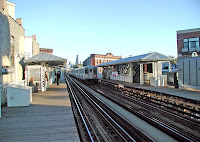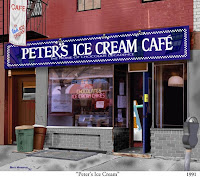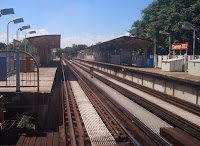

 Station di Damen
Station di Damen

Photo colection
About Photoshop CS3 Download Tutorial
Style Hair Cut
One thing that bugs me when viewing images either on or off the web, especially in magazines, is the shoddy cutouts around a person. Due to tight time restraints it is much quicker to add a rough trim to a photo with the hopes that people wont be bothered.
Well there is a way in Photoshop to quite easily re-create a hair effect after a rough trim, and it only uses one tool!
This technique produces best results when using some form of graphics tablet. It can be done using a mouse but it is a little more challenging to achieve smooth curves and effects.
Generally when cutting out people in photographs, the majority of the work is pretty straight forward. Everyone has their own techniques for this, but time after time there seems to be this trend for just rough cutting around the hair line.
In this tutorial I will show you a very simple way to cut out a photograph and deal with the sticky situation of the ‘Cut out hair’. We will be re-creating the hair in a neat and tidy manner, allowing the photograph to be placed on a range of backgrounds.
Lets crack on… Firstly we need to select a photograph.
Here I have chosen a male model with spiky hair. My main reason for this is it will enhance the effect and show off the technique better than say a female with straight hair. Although the technique works for all hair types! In case anyone was thinking I am a ‘hairist’!
This image is royalty free and can be downloaded here.
First of all we are going to perform a rough cutout of the model. We need to create a new transparent layer in Photoshop and set it beneath our image layer. As I mentioned above, there are many techniques of cropping and cutting out images, in this tutorial I will be using the Polygonal Lasso Tool (L) I will not be masking any layers as we will be directly editing the cutout.
So start off by cutting out the body, neck and lower face of the model up to the bottom of the hairline just above the ear.
You may notice the image used is a low resolution image. Again this is only for the purposes of this tutorial, and in fact the technique works much better in higher resolutions.
At this stage we are still rough cutting. For the next step we are going to perform the first trim around the models head. This can be as rough as you like but be sure not to cut to deep into the shape of the head and try to imagine and follow a rough line where you would imagine the hair spikes to be. I have deliberately cut to deep in the image below to show how easily this technique can rectify a mistake.
The close up view shows how accurate/inaccurate you need to be.
As you can see below, we are now at a stage where the model is fully cut out with a rough edge around the hairline.
OK we are now ready to give this guy a better haircut! This whole technique works around the ‘Smudge’ Tool (R). Now, for this particular image I have chosen the following settings for my smudge tool.
If you select the smudge tool and then edit the Brush Preset. You need to use a standard brush head, we will manually set the size to 1px and set the hardness to 80%. Close the Brush Preset and set the strength of the smudge tool to 80%. As I said, these setting will work nicely for this image, but for a higher resolution image you may want to play around with the brush sizes and strengths.
It is always good to keep the brush tool pretty hard or the hair goes to wispy. Last setting to check before we continue is to make sure the ‘Sample all layers‘ box is unchecked. This will smudge all layers and will mess up your background image if you were editing on top of one.
The first thing I would say before we start is to always try to follow the current direction of the hair, don’t be worried to throw in some curves and cross overs as no hair is perfect! In fact the more perfect you make this the less realistic it will be. And always try to work outwards away from the face unless you are doing tidy up strokes or working with long hair.
It doesn’t really matter where you start on the hair as it will all flow into itself as you move around.I will try to show my motions through this one section of the hair. The blue lines show pulls or drags away from the face, the red lines show corrections or drags into the face. The correction lines are for removing any stray wispy/blurry sections. I call it ‘cutting in‘.
As you can see I have worked with the image and the natural hair line to extend and enhance the edging. The deeper the pull the further forward the hair should be as you will be overlapping previous smudges. I would advise working from back to font by editing the outside hair first and working inwards.
Continue doing this around the full circumference of the hairline.
And that is it! One technique to create a nicely cut out head of hair. You can now look to place your image on any background and any colour varient you like. Below are some examples…
Hope you like the tutorial! Give it a go, its a really easy technique and you can get some very nice results.
Well what I want to show here is how to create a nice light and magic effect.
1 - Create a radial gradient, in this case from a purple to a really dark purple
2 - Here I added a really cool Icon of a magic hat from the Crystal Clear Collection by Everaldo
3 - Add some text, I used the source code of a site to get the text and apply the Distort >Wave filter
Create two stripes of text
4 - Rotate and place the text
5 - Add some light using glow : Use different values for each line of text, the secret here is the blending option COLOR DODGE..
Change the values of Spread, Size and Range
6 - Group the 2 lines of texts and with one apply a mask to make the stripes disappear at their ends.
7 - With the other group of text apply a gausian blur, after that delete some parts to show the non-blury text.
This will add a movement feel to the text, like they are really being magicaly created.
8 - Create a new layer below the text and with a regular big brush like 100px add a spot of light in white.
The layer must be below the text, otherwise the glow will not affect the white spot
9 - Make some smoke again, I used the eraser, I could've used the liquify as well
10 - Create a cloud: to do that make use a marquee with feather set to a value bigger than 20 and apply the render>clouds holding the command key(mac), ctrl key(win).
The same as the previous post, and the most important thing apply the COLOR DODGE blending options on it
11 - Sparks: For the sparks create a brush, play with the shape dynamics, scatering, and other dynamics. After that, apply a Outer Glow and Inner Glow to create the magic effect.
End - The result is really simple but at the same time it looks beautiful.
The whole process took me about 35 minutes, one thing I think is really cool is to apply the color dodge blending option to folder, and put blured elements inside of it. Using it you can create some really amazing light effects.
Create a new document, apply a Layer Style on the background layer. Add a Gradient Overlay and a Pattern Overlay.
Here I've used an icon I found on a cool site, but you can use whatever you want.
Select the Ellipse Tool (U) and create a shape like I did. After that apply a Gaussian Blur (Filter>Blur>Gaussian Blur) with radius of 30px.
Create a new Folder name it “Light Effects”. Change its blend mode to Color Dodge, and move the ellipse you created to this folder.
In order to create the sparks we will use the amazing brush engine. Add a new layer, inside the “Light Effects” layer, set white for the color and follow the images below.
Using the Layer Styles add a Outer Glow to the sparks
Lets add some smoke. Create a new Layer, call it “Smoke”. Change its blend mode to Color Dodge and select the Lasso Tool. Set 40px for Feather and create a selection like I did below. After that make sure that the foreground is white and the background is black and apply a Filter>Render>Clouds. Tip: Continue applying the filter until you get the best clouds.
Add some text and using the Layer Styles again lets create a nice effect.
Place your logo and you can even add more effects like I did on the Magic Lighting Effect, but then you will have to follow that tutorial ;).
I have to say, if you know a bit of Layer Styles and the Brush engine in Photoshop you will be able to create amazing effects. It will depend exclusively on your imagination and playing with the tool. Sometimes just changing a some settings and you get a totally different effect.
| Yes indeed, this is a hell of a red eye. To make it worse, the effects in the two eyes differ in lightness. In such cases, you should treat the eyes one by one. Press M to select the elliptic selection tool, and draw a marquee around one eye. You should select an area 1-2 pixels larger than the actual red eye. Right-click the selection and choose Feather in the shortcut menu. This feature softens the edges of the selection. Set a Radius of 2 to 3 on the dialog that appears. The selection should be softened so that the edge of the retouched area shows a nice transition instead of a sharp boundary. Next, click Image/Adjustments/Desaturate to make the selection colorless. Redness is gone, but the eye still glows just like before. You have to darken it. Click Image/Adjustments/Levels to do so. Type 0 or a near-zero value into the Input Levels field in the middle. You can also use the grey middle arrow under the histogram. Drag it to the extreme right. In certain cases a totally black pupil can ruin the authenticity of the photo if the whole picture doesn’t contain any black. In such a case, drag the black left arrow on the Output Levels dialog further to the left until you get an appropriate grey result. The inside of the eye is dark enough, but the image still needs some work as the pupils are unrealistically wide. For the simplest method, click Filter/Other/Maximum and set a radius of 2 to 3 pixels. This will also make the twinkle in the pupil a bit larger and more square. To make the effect more realistic, select the Blur Tool from the tools palette (or press R) with a small brush size (about 5 to 10 pixels) and carefully paint over the twinkle to soften it.
|
| |||||||||||
| |||||||||||
Open the photo you wish to edit.
This time, let us focus on the red eye only.
In the Navigator window in the upper-right corner, set zoom to 200-300% (the larger, the better). The aim is to fill the workspace with the red eye(s). Zoom is required for accurate work.
The Sponge Tool, located on the left-side toolbar, is a good friend in many situations. It can be most easily evoked by pressing O. If the icon on the picture is inactive, hover the pointer over the icon (while pressing down the left button), and you can select the Sponge Tool from the appearing list.
Now that you have selected the tool, set its properties. In Photoshop 7.0 and newer versions, you can find the properties for the current tool on the top of the screen, directly below the main menu. In earlier versions, you can select Options and Brushes among the windows on the right.
First of all, select an adequately sized brush from the upper row of properties. The Sponge Tool will work with this diameter and properties. Red eye removal is best done with a soft brush with a size of 5 to 15 pixels. I have chosen a 9-pixel one. Diameter should always be less than the size of the red eye effect. In the Mode property window, choose Desaturate, as we want to decrease the intensity of a color. Flow shows the strength of the tool. Set it to 100%.
With the Sponge Tool brush, paint inside the red eye area with single clicks, and observe the red color slowly fading. After fading out both red eyes (or just one, if there's but a single eye showing :)), take a look at the picture to judge how natural the blacks of the eyes look. When dealing with darker reds, desaturation usually gives good enough a result, but "fully flashed", very bright red eyes require further treatment.
On this picture, the left eye is almost good, but the right one, being lighter, is rather unnatural.
Let's work on it a while more! Click on the same icon where you have found the Sponge Tool and leave the mouse button pressed. On the dropdown list, click the Burn Tool!
On the upper properties bar, set the Brush size to a bit smaller than the size of the pupil. On this picture, I found a size of 20 to 25 pixels appropriate. Set Range to Midtones, as we want to darken only the midtones of the picture, and set Exposure to a low value to enable fine work. I used a value of 20%. Now, once again with single clicks inside the black of the eye, darken it to the desired extent. The exact degree is up to you, the main thing is to reach a naturally-looking eye as a result. This is usually not done by darkening to absolute black. Click more into the center of the pupil to make it darker than the edges, which can remain a bit lighter. This also emphasizes the natural character of the eye. Exact degrees are determined by your sense of beauty - remember, this is why you can achieve better results than an automated program!
And here it is, the final result:
Later we will show a similar but slightly more complex process for the same purpose.